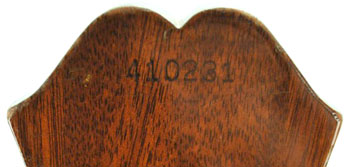Epiphone Serial Numbers Made In Japan
Part II ------------------------------------------------------------------------------------- F-Serial used on LP Std'59/'60 models and Tribute/Plus models This newest serial number system used by Epiphone is not yet completely deciphered. 'F' doesn't refer to 'Fine, Korea' - nor to 'Fuji-gen, Japan' - New 'F' models are made in China. This serial number system doesn't exactly tell the year - and doesn't tell the month at all. Drug Use And Abuse Maisto 6th Edition Companion Site For Discovering. • Beginning with F300000 in late 2009 used on LP Std'59/Std'60/Tribute models • Continued around F310650~F311050 in spring 2012 on Tribute-Plus models • Continued around F305000 in 2011 • Continued around F310000 in 2012 • Continued around F317000 in 2013 • Continued around F324000 in 2014 • Continued around F330000 in 2015 ------------------------------------------------------------------------------------- Epiphone Japan Serial Numbers 1998-Current The Yamano Gakki Epiphone Japan serial numbers from 1998 onwards are in a YMMPPP format.
Y = Year of manufacture MM = Month of manufacture PPP = Production number The serial number letters used by the Terada and Fuji-Gen guitar factories are: • J = Terada • T = Terada, • F = Fuji-Gen • No Letter = Fuji-Gen Example: J902123 = Terada / 1999 / February / unit 123 Example: T902123 = Terada / 1999 / February / unit 123 Example: F902123 = Fuji-Gen / 1999 / February / unit 123 Example: 902123 = Fuji-Gen / 1999 / February / unit 123 1987-1997 For Yamano Gakki Epiphone Japan semi acoustic models from 1987 to approximately 1997, the serial numbers are in a YCPPP format. They were made by Terada and usually have an Orange Epiphone label.
Charlie, if this has been posted before please delete it or move it. There are 4 distinct 'eras' of Epiphone: A) House of Stathopoulo (1873 - 1957); B) Gibson Kalamazoo (1957 - 1970); C) Japanese (1970 - 1983); D) Korean (1983 - Present); The original Epiphone factory was in New York, when the company was owned and operated by the Stathopoulo family. That was the era of the legendary archtops like the Regent, Broadway, Deluxe, etc. In 1957, Epiphone was tenuously clinging to existence; the company had been bought out by the C.G. Conn company (best known for band and orchestral instruments), and was all but out of business. Gibson President Ted McCarty (who recently passed away; R.I.P., Ted) negotiated a deal to buy out Epiphone's upright bass business, but when the equipment was moved to Gibson's Kalamazoo factory, McCarty found out that *all* of Epiphone's equipment, tooling, and parts inventory had been included. That led to Gibson building Epiphones in the Gibson factory; the first few years (1958-61), Gibson used up all the old parts, and in the early 60's, used Gibson parts.


I cannot say for sure if it was made in kalamazoo, Mi.; I suspect it was. Maybe the guitar isnt as old as we're thinking. Does anyone know when epi manufacture was exclusive to Japan? Other ways of dating guitars is by looking at the type of tuners, bridge design, pegs, wood. Lots of things. 3.5) The Epiphone serial number decoder currently supports 12 serial number formats from 25 factories. Vintage numbers from 1932 to 1970 are supported. Serial numbers from 70' and 80's era Epiphone guitars made in Japan are not supported. The reason for this is that there is no reliable documentation from this.
This worked well for both Gibson and Epiphone, because it allowed music dealers who couldn't get an official Gibson franchise (which were *very* strictly enforced in those days) to get an Epiphone (which had become a quasi-Gibson) franchise instead. In 1969, Norlin Industries bought the Chicago Musical Instrument company (which owned Gibson at the time), which heralded the 'Dreaded Norlin Era' at Gibson, in which the quality declined greatly.
Epiphone production was contracted to companies in Japan in order to cut costs. The Japanese Epis are good guitars, but they suffered both the 'Made in Japan' and 'Norlin' stigmas; they've always been under-rated as a result. In 1983, around the time that Gibson was bought by a group headed by Henry Juszkiewicz (now President of Gibson USA), Epiphone production was contracted to Korean companies, most notably Samick (of which Epiphone/Gibson owns a significant percentage). With some exceptions, Epiphones are made in Korea to this day. Most Epiphones can be dated fairly accurately by their serial numbers. The exception to this is the Japanese-era guitars; the serial numbering doesn't seem to have followed any sequential pattern from year to year, which makes it *very* difficult to date them accurately.
Original Epiphones had a number of different serial numbering schemes, depending on the year. Gibson-built Epiphones followed the Gibson serial numbering scheme. Korean-made Epiphones have a letter (manufacturer's ID code) and a 7 or 8-digit serial number as follows: First digit (7) or first 2 digits (8): Year of manufacture. Next 2 digits: Month of manufacture. Last 4 digits: Production sequence number. Epiphone hasn't released particulars of the letter ID codes at this point. A reference to Epiphone serial numbers is available at in PDF (Adobe Acrobat) format. Vcardorganizer 2.1 Serial more.